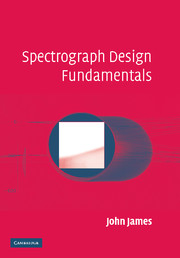Book contents
- Frontmatter
- Contents
- Preface
- Acknowledgements
- 1 A brief history of spectroscopy
- 2 The relevant regions of the electromagnetic spectrum
- 3 Geometrical optics
- 4 Optical aberrations
- 5 Fourier transforms: a brief revision
- 6 Physical optics and diffraction
- 7 The prism spectrograph
- 8 The plane grating spectrograph
- 9 The concave grating spectrograph
- 10 The interference spectrograph
- 11 The multiplex spectrometer
- 12 Detectors
- 13 Auxiliary optics
- 14 Optical design
- 15 Mechanical design and construction
- 16 Calibration
- 17 The alignment of a spectrograph
- Appendix 1 Optical aberrations
- Appendix 2 Wavelengths of spectral lines for calibration
- Appendix 3 The evolution of a Fabry–Perot interference spectrograph
- Appendix 4 The common calibration curve in silver halide spectrophotometry
- Bibliography
- Index
Appendix 3 - The evolution of a Fabry–Perot interference spectrograph
Published online by Cambridge University Press: 02 September 2009
- Frontmatter
- Contents
- Preface
- Acknowledgements
- 1 A brief history of spectroscopy
- 2 The relevant regions of the electromagnetic spectrum
- 3 Geometrical optics
- 4 Optical aberrations
- 5 Fourier transforms: a brief revision
- 6 Physical optics and diffraction
- 7 The prism spectrograph
- 8 The plane grating spectrograph
- 9 The concave grating spectrograph
- 10 The interference spectrograph
- 11 The multiplex spectrometer
- 12 Detectors
- 13 Auxiliary optics
- 14 Optical design
- 15 Mechanical design and construction
- 16 Calibration
- 17 The alignment of a spectrograph
- Appendix 1 Optical aberrations
- Appendix 2 Wavelengths of spectral lines for calibration
- Appendix 3 The evolution of a Fabry–Perot interference spectrograph
- Appendix 4 The common calibration curve in silver halide spectrophotometry
- Bibliography
- Index
Summary
This is to show the stages of evolution of a design for a Fabry–Perot spectrograph for night airglow or astronomical applications.
Astronomical considerations required that the resolution should be 1.2 Å at 5183.6 Å, the wavelength of the Mg triplet of solar Fraunhofer lines. The free spectral range was to be about 20 Å, set by the FWHM of the interference filter which was to act as order-sorter. The available finesse was 40 and this constrained the étalon gap thickness to be 28 µm. The order at the centre of the ring system is then 56 µm/0.5183.6 µm = 108.
The available CCD camera used a 50 mm F/1.4 ‘Takumar’ lens and a CCD with 1152 × 325 pixels each 25 µm square. The field semi-angle was then 16°. A primary requirement was for spatial resolution, so that both the sky and the Fabry–Perot fringes were to be in focus on the CCD. It was also required that the angle subtended by the CCD on the sky should not be greater than ∼5°.
The étalon gap thickness determined the angular radii of the Fabry–Perot rings (assuming m0 = 108 at the centre) which are given by cos θn = (m0– n)/m0 with n = 1, 2, 3 … so that cos θ1 = 7.8°. The next rings are at 11.04° and 13.53°.
[…]
- Type
- Chapter
- Information
- Spectrograph Design Fundamentals , pp. 183 - 185Publisher: Cambridge University PressPrint publication year: 2007



